|
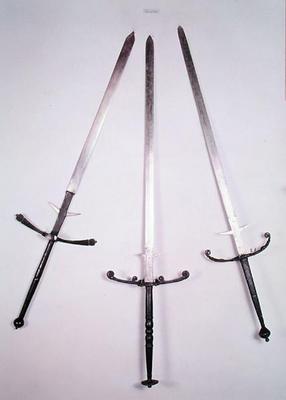 The
Two-Handed Great Sword The
Two-Handed Great Sword
Making lite of the issue of weight
By Anthony
Shore
For many
years in the historical-reenactment/renaissance faire communities,
I have listened to lectures regarding the weight of the two-handed
great sword. I have heard endless stories of how this magnificent
weapon often weighed in excess of 20 pounds with such justifications
as they "needed to be heavy to smash through plate armor or to
unhorse knights on the battlefield." Other arguments include
such claims as how Medieval Europeans somehow did not possess the
technology to produce lightweight, quality steel weapons. This kind
of statement usually includes some reference to Japanese swords and
"technologically superior" folded steel.
The respected work, Swords and Hilt Weapons, offers this description
of the weapon:
"The two-handed sword was a specialized and effective infantry
weapon, and was recognized as such in the fifteenth and sixteenth
centuries. Although large, measuring 60-70 in/150-175 cm overall,
it was not as hefty as it looked, weighing something of the order
of 5-8 lbs/2.3-3.6 kg. In the hands of the Swiss and German infantrymen
it was lethal, and its use was considered as special skill, often
meriting extra pay. Fifteenth-century examples usually have an expanded
cruciform hilt, sometimes with side rings on one or both sides of
the quillon block. This was the form which remained dominant in
Italy during the sixteenth century, but in Germany a more flamboyant
form developed. Two-handed swords typically have a generous ricasso
to allow the blade to be safely gripped below the quillons and thus
wielded more effectively at close quarters. Triangular or pointed
projections, known as flukes, were added at the base of the ricasso
to defend the hand." (p. 48)
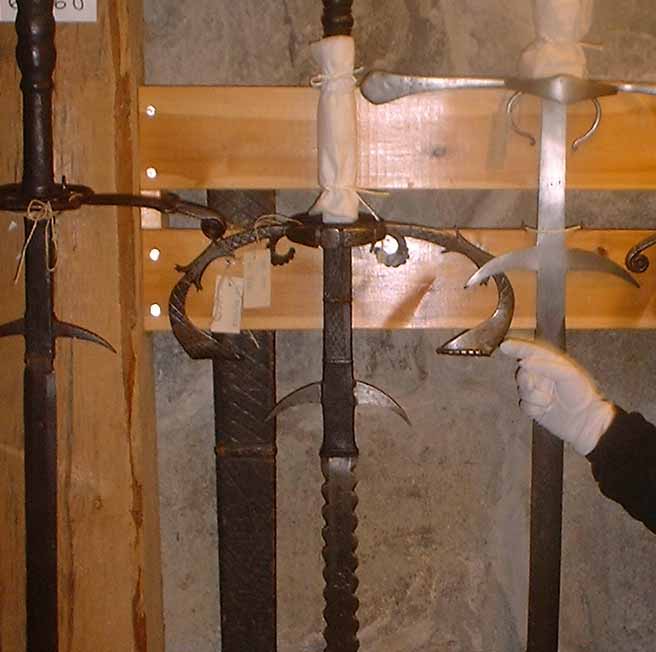 The
purpose of this article is to dispel some of the myths and misinformation
that have been circulating around the Renaissance Faire and the Highland
Games communities as well as among sword enthusiasts in general regarding
the two-handed great sword. While I am certainly no expert in the
field myself, I do know how to ask questions and whom to ask. Over
a period of some eight weeks I corresponded on the subject of the
two-handed great sword with arms curators and authorities at various
museums and armories throughout Europe. This article is a compilation
of data based on some of the responses I have received as well as
information from other sources on the subject. The
purpose of this article is to dispel some of the myths and misinformation
that have been circulating around the Renaissance Faire and the Highland
Games communities as well as among sword enthusiasts in general regarding
the two-handed great sword. While I am certainly no expert in the
field myself, I do know how to ask questions and whom to ask. Over
a period of some eight weeks I corresponded on the subject of the
two-handed great sword with arms curators and authorities at various
museums and armories throughout Europe. This article is a compilation
of data based on some of the responses I have received as well as
information from other sources on the subject.
Factual Evidence as to Weight
Robert C. Woosnam-Savage of the Royal Armouries at Leeds writes:
"The fighting two-handed sword, weighed (on average) between
5-7 lbs. I give the following three examples, randomly chosen from
our own collections, which I hope are adequate to make the point:
Two-handed sword, German, c.1550 (IX.926) Weight: 7 lb 6oz.
Two-handed sword, German, dated 1529 (IX.991) Weight: 5 lb 1oz.
Two-handed sword, Scottish, mid 16th century, (IX.926) Weight: 5
lb 10oz.
(I know another of this last type, in a Glasgow Museum, that weighs
in at 5 lbs exactly!)."
Robert C Woosnam-Savage
Curator of European Edged Weapons
In an e-mail correspondence with Mr. David Edge of the Wallace Collection
in London, Mr. Edge states:
"Original weapons are indeed far lighter than most people
realize… 3lbs for an 'average' late-medieval cross-hilt sword,
say, and 7-8 lbs for a Landsknecht two-handed sword, to give just
a couple of examples from weapons in this collection. Processional
two-handed swords are usually heavier, true, but rarely more than
10 lbs. The heaviest and most enormous sword in our entire Armoury
only weighs 14 lbs and was probably ceremonial."
David Edge
Acting Head of Conservation, and Armoury Curator/Conservator
Henrik Andersson, an archives librarian at the Royal Armoury of Stockholm,
offered a detailed categorized list of some of their collection. Below
are some of the examples in the armouries collection of two-handed
weapons, their weights and dimensions and approximately when they
were made or commonly used. Mr. Andersson supplied this list in metric
which I have translated into U.S. Standard. Unlike the ceremonial
pieces, none of the fighting weapons exceeded 4 pounds and the heaviest
ceremonial was less than 11.
Two-handed sword
(Germany) Fifteenth C.
Length: 1375 mm (54.21 inches)
Blade: 920 mm (36.2 inches)
Weight: 1600 gr (3.5 lbs) |
Ceremonial Two-handed sword
(Germany) c. 1600
Length: 1275 mm (50.19 inches)
Blade: 1000 mm (39.37 inches)
Weight: 2330 gr (5.1 lbs) |
Two-handed sword
(Germany) 1475-1525
Length: 1382 mm (54.40 inches)
Blade: 1055 mm (41.53 inches)
Weight: 1550 gr (3.41 lbs) |
Ceremonial Two-handed sword
(Germany) end of Sixteenth C.
Length: 1422 mm (55.98 inches)
Blade 1029 mm (40.51 inches)
Weight: 2700 gr (5.95 lbs) |
Two-handed sword
(Germany ) end of Fifteenth C.
Length: 1473 mm (58 inches)
Blade: 1066 mm (41.97 inches)
Weight: 2720 gr (5.99 lbs) |
Ceremonial Two-handed sword
(Munich) 1575
Length: 1643 mm (64.69 inches)
Blade: 964 mm (37.95 inches)
Weight: 3500 gr (7.72 lbs) |
Two-handed sword
(Germany) c. 1500
Length: 1340 mm (52.75 inches)
Blade: 955 mm (37.6 inches)
Weight: 1390 gr (3.06 lbs) |
Ceremonial Two-handed sword
(Germany) end of Sixteenth C.
Length: 1817 mm (71.53 inches)
Blade: 1240 mm (48.81 inches)
Weight: 3970 gr (8.75 lbs) |
One-and-a-half-handed sword
(Germany) c. 1475-1525
Length: 1153 mm (45.39 inches)
Blade: 932 mm (36.69 inches)
Weight: 1320 gr (2.91 lbs) |
Ceremonial Two-handed sword
(Germany) end of Sixteenth C.
Length: 1893 mm (74.52 inches)
Blade: 1313 mm (51.69 inches)
Weight: 4830 gr (10.64 lbs) |
A question of technology
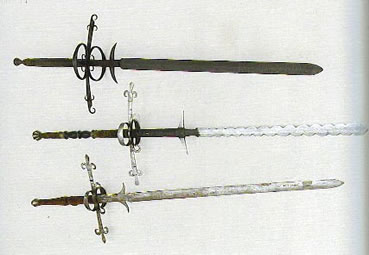 In
movies and other popular media we often are given the impression that
European sword smiths were large, brutish folk who were not the brightest
of people and capable only of pounding out rough hewn, iron blades.
(This kind of statement usually includes some reference to the masterful
Japanese working with folded steel--disregarding that the Japanese
never developed the spring steel technology which made European swords
so resilient and flexible). The mistake here may be that we confuse
swordsmithing with blacksmithing…which is similar, but not quite
the same thing. Swordsmiths of the day were often very intelligent,
learned craftsmen who gave a great deal of time to the study of metals
and, the forging of a good sword was often the cumulative effort of
a group of highly skilled and artistic men, each with his own specific
task in the creation of a weapon. There were often entire villages
or towns such as Passau or Solingen, Germany, or Toledo in Spain which
were dedicated to the construction and forging of arms and armour. In
movies and other popular media we often are given the impression that
European sword smiths were large, brutish folk who were not the brightest
of people and capable only of pounding out rough hewn, iron blades.
(This kind of statement usually includes some reference to the masterful
Japanese working with folded steel--disregarding that the Japanese
never developed the spring steel technology which made European swords
so resilient and flexible). The mistake here may be that we confuse
swordsmithing with blacksmithing…which is similar, but not quite
the same thing. Swordsmiths of the day were often very intelligent,
learned craftsmen who gave a great deal of time to the study of metals
and, the forging of a good sword was often the cumulative effort of
a group of highly skilled and artistic men, each with his own specific
task in the creation of a weapon. There were often entire villages
or towns such as Passau or Solingen, Germany, or Toledo in Spain which
were dedicated to the construction and forging of arms and armour.
How was this weapon used?
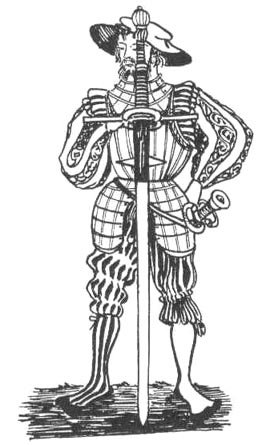 Part
of the "myth" surrounding this weapon may be from a lack
of understanding of how it was used. As weapons, swords are designed
to fill specific needs. In a fight, one gains an advantage in several
ways, two of which are: keeping your opponent from getting close enough
to strike and, being able to strike your opponent before he can strike
you. This requires two things; 1: A weapon capable of striking from
a distance and, 2: A weapon light enough to be wielded quickly. One
of the advantages of this weapon was length, which meant it had greater
ability to reach an opponent from a distance while preventing him
from reaching you. An inordinately heavy blade could not accomplish
these goals. Part
of the "myth" surrounding this weapon may be from a lack
of understanding of how it was used. As weapons, swords are designed
to fill specific needs. In a fight, one gains an advantage in several
ways, two of which are: keeping your opponent from getting close enough
to strike and, being able to strike your opponent before he can strike
you. This requires two things; 1: A weapon capable of striking from
a distance and, 2: A weapon light enough to be wielded quickly. One
of the advantages of this weapon was length, which meant it had greater
ability to reach an opponent from a distance while preventing him
from reaching you. An inordinately heavy blade could not accomplish
these goals.
The two-handed sword was also versatile in the variety of ways it
could be used, the blade for cutting and thrusting, the hilt for smashing
(or more appropriately, pummeling) and, the cross (quillons) for hooking
either your opponent or his weapon. With this in mind, I am left thinking
that this weapon required more skill than muscle to wield. Why is
it then that we so often hear and see such fantastic stories of massively
heavy weapons wielded by Herculean warriors? Because this is what
the media gives us and for some, it's probably just easier to believe
what they see in the movies and accept it as fact. But also, this
is what we expect of our heroes. A super human hero requires an equally
powerful weapon. Reality and myth often clash and the truth gets lost
in the story. (See: Fence
With All Your Strength).
Vivian Etting, Curator of the National Museum of Denmark, in a recent
correspondence offered the following:
"In the Medieval and Renaissance collections at the National
Museum of Denmark we have several very fine two-handed swords. This
type of sword was used primarily in middle and northern Europe from
about 1400 up to the beginning of the 16th Century. It was a combined
cut-and-thrust weapon, which often was manufactured in Passau or
Solingen in Germany. Originally it was a sword, used by armed knights
on horseback, but in the end of the 15th century it was used by
the infantry as well. Thus the big cavalry sword developed into
the two-handed sword, which in turn became the weapon of the Landsknecht."
John Clements offers this summation of the weapon:
"In contrast to longswords, technically, true
two-handed swords (epee's a deux main) or "two-handers"
were actually Renaissance, not Medieval weapons. They are really
those specialized forms of the later 1500-1600's, such as the Swiss/German
Dopplehänder ("double-hander") or Bidenhänder
("both-hander"). The popular names Zweihander /
Zweyhander are actually relatively modern not historical
terms. English ones were sometimes referred to as "slaughters-words"
after the German, Schlachterschwerter ("battle swords").
While used similarly to longswords, and even employed in some duels,
they were not identical in handling or performance. No historical
sources for fencing with these specific weapons have survived. These
weapons were used primarily for fighting among pike-squares where
they would hack paths through lobbing the tips off opposing halberds
and pikes then slashing and stabbing among the ranks. Wielded by
the largest and most impressive soldiers (Doppelsoldners,
who received double pay), they were also used to guard banners and
castle walls.
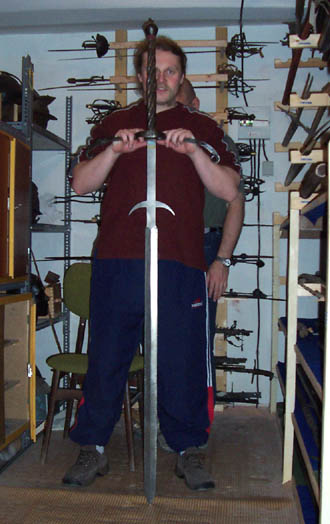 Many
of these weapons have compound-hilts with side-rings and enlarged
cross-guards of up to 12 inches. Most have small, pointed lugs or
flanges protruding from their blades 4-8 inches below their guard.
These parrierhaken or "parrying hooks" act almost as a
secondary guard for the ricasso to catch and bind other weapons
or prevent them from sliding down into the hands. They make up for
the weapon's slowness on the defence and can allow another blade
to be momentarily trapped or bound up. They can also be used to
strike with. Certain wave or flame-bladed two-handed swords have
come to be known by collectors as flamberges, although this they
are more appropriately known as flammards or flambards (the German,
Flammenschwert). The wave-blade form is visually striking
but really no more effective in its cutting than a straight one.
There were also huge two-handed blades known as "bearing-swords"
or "parade-swords" (Paratschwert), weighing up
to 12 or even 15 pounds and which were intended only for carrying
in ceremonial processions and parades." Many
of these weapons have compound-hilts with side-rings and enlarged
cross-guards of up to 12 inches. Most have small, pointed lugs or
flanges protruding from their blades 4-8 inches below their guard.
These parrierhaken or "parrying hooks" act almost as a
secondary guard for the ricasso to catch and bind other weapons
or prevent them from sliding down into the hands. They make up for
the weapon's slowness on the defence and can allow another blade
to be momentarily trapped or bound up. They can also be used to
strike with. Certain wave or flame-bladed two-handed swords have
come to be known by collectors as flamberges, although this they
are more appropriately known as flammards or flambards (the German,
Flammenschwert). The wave-blade form is visually striking
but really no more effective in its cutting than a straight one.
There were also huge two-handed blades known as "bearing-swords"
or "parade-swords" (Paratschwert), weighing up
to 12 or even 15 pounds and which were intended only for carrying
in ceremonial processions and parades."
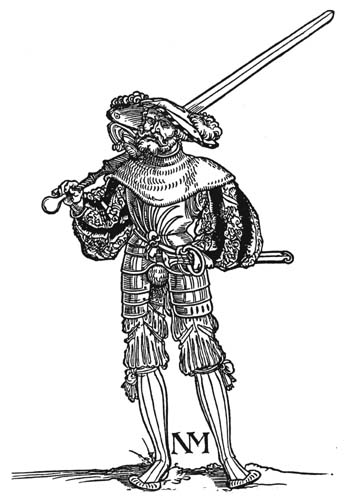 What
about that Plate Armour? What
about that Plate Armour?
Again, it is from a lack of understanding not only of this weapon
but of plate armour that we hear arguments as to how this sword "had
to be large and heavy" in order to smash or cut through it. Warriors
realized that trying to cut through plate with a sword was folly.
More often than not, significant damage would be done to any sword
when trying to "cleave" through plate armor, but you could
get in between the joints with the point of a weapon. Being able to
"punch" through plate was more effective than trying to
hack or bash through it, but if one was determined to actually cut
into a knight outfitted in plate armour, there were much better tools
such as a warhammer or an axe, which had a wide enough blade and could
handle the shock of striking a surface that hard without sustaining
a great deal of damage.
Conclusion
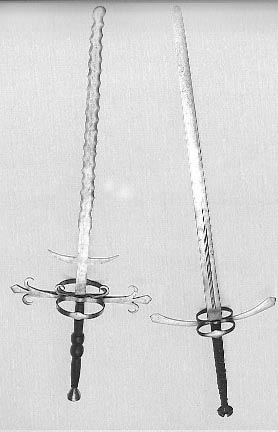 We
can see by the evidence offered from the academic professionals and
other sources presented in this essay, that the two-handed great sword
of Europe was not the crude, lumbering, bludgeon with a point that
it has been made out to be. Although it is considerably heavier than
its smaller relatives, it is still in fact, an agile, lightweight
weapon and if used properly, an incredibly deadly tool for both close-quarter
combat and all-out battlefield melees. We
can see by the evidence offered from the academic professionals and
other sources presented in this essay, that the two-handed great sword
of Europe was not the crude, lumbering, bludgeon with a point that
it has been made out to be. Although it is considerably heavier than
its smaller relatives, it is still in fact, an agile, lightweight
weapon and if used properly, an incredibly deadly tool for both close-quarter
combat and all-out battlefield melees.
This weapon was intended for fighting among the close-pike formations
of the new style of warfare emerging among late 15th and early 16th
century battlefields. It could chop at the shafts of opposing weapons
and when needed be used almost like a pole-arm itself. It was also
an effective tool for dealing with fully armoured mounted knights.
The technology for forging steel has been around for centuries and
a knowledgeable armourer could forge a lightweight, flexible, quality
steel blade that did its job extremely well in the hands of a skilled
warrior.
See
Also:
What did Historical
Swords Weigh?
Academic and Professional Acknowledgements:
Robert C. Woosnam-Savage, is a co-author of "Brassey's
Book of Body Armour" and, was Curator of European Arms and Armour
at the Glasgow Museums from 1983-1997 before joining the Royal Armories
at Leeds as curator of European-Edged Weapons. http://www.armouries.org.uk
David Edge, Author of "Arms and Armour of the
Medieval Knight," has given to the world a worthy gift that encapsulates
something of the knowledge he's built in nearly two decades of study
working with the Wallace Collection in London, England. http://www.wallacecollection.org
Henrik Andersson, Royal Armouries of Stockholm, http://www.lsh.se/livrustkammaren/Thehela.htm
Vivian Etting, Curator at the National Museum of Denmark
http://www.natmus.dk/sw1413.asp
John Clements, the Association for Renaissance Martial
Arts. http://www.thearma.org
Special thanks to Michael Campbell of the Alameda
Newspaper Group for his invaluable editing assistance and guidance.
On Line Articles and Resources:
"The Serpent in the Sword, Pattern-welding in
Early Medieval Swords" by Lee A. Jones
http://www.vikingsword.com/serpent.html
"Origins of the Two-Handed Sword" by Neil
H.T. Melville, published in the Journal of Western Martial Art January
2000. http://www.ejmas.com/jwma/articles/2000/jwmaart_melville_0100.htm
"Polished Steel, The Art of the Japanese Sword."
A Lecture given at London University, December 6, 1996 By Kenji Mishina.
http://www.galatia.com/~fer/sword/mishina/lecture.html
"What did Historical Swords Weigh?" by John
Clements, Director of the Association for Renaissance Martial Arts.
http://www.thearma.org/essays/weights.htm
"The Key Role of Impurities in Ancient Damascus
Steel Blades"
http://www.tms.org/pubs/journals/JOM/9809/Verhoeven-9809.html
Higgins Armory Museum
http://www.higgins.org/Research/resources.shtml
Suggested reading:
Blankwaffen. Geschichte und Typenentwicklung im
Europäischen Kulturbereich. By Dr. Heribert Seitz.
Wallace Collection Catalogue. 1962 two-volume
set, by James Mann, plus the 1986 Supplement by A.V.B. Norman. (Contains
weights of every edged weapon in the collection as well as weights
of body armour).
Records of the Medieval Sword. The Boydell
Press 1991 and "The sword in the Age of Chivalry" 1964,
By Ewart Oakeshott.
Swords and Hilt Weapons. M. Coe, et al. Barnes
and Noble Books of New York, 1993.
About the author:
Anthony
Shore is by trade an IT professional but has been fascinated by Medieval
weapons since early childhood. Anthony has been involved for over
10 years in the Historical Reenactment community and has been associated
with a number of guilds focusing on Scottish history and culture between
the
14th and 16th centuries."
|

